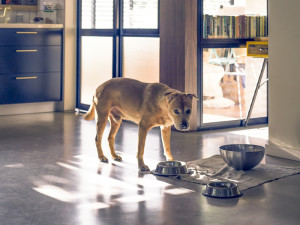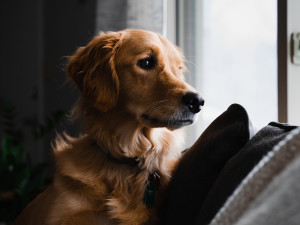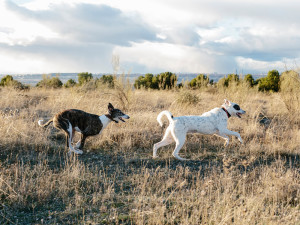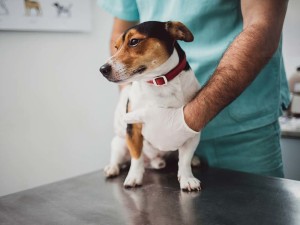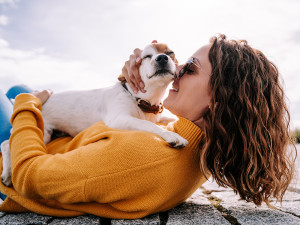Home Remedies For My Dog’s Bleeding Anus
It’s not a pretty problem, but here are your solutions.

share article

Your pet wants you to read our newsletter. (Then give them a treat.)
Some common causes of anal bleeding include anal gland disease, dietary issues, intestinal parasites, and infections. Home remedies may include warm compresses and dietary adjustments. A vet should always be consulted before attempting any treatment. Seek immediate veterinary care for severe or persistent symptoms.
What are the symptoms of a bleeding anus in dogs?
There’s going to be a lot of butt and butt-adjacent discussion in this article, so put down your lunch and brace yourself for an adventure. Symptoms of a bleeding anus in the dog are usually first noted by pet parents noticing blood on the rear end. Other clues that could indicate a bleeding anus include:
Drops of blood on the ground
Discomfort or straining when defecating
Excessive licking at the rear end
Blood around the mouth (transferred from licking)
Hiding
Whining or acting painful
Swelling around the anus
Nothing’s worse than finding evidence of blood in your house and having to figure out where it came from. In addition to checking on family members and/or roommates, take a close look at your pets and make sure no one’s gotten into trouble. Pet parents often think to look for things like woundsopens in a new tab and broken toenailsopens in a new tab, but they may forget to check under the tail to make sure nothing’s going wrong back there.
What could be causing my dog’s bleeding anus?
Blood coming from or found around a dog’s anus can have many sources. Knowing a little local anatomy can help to narrow down the causes of a bleeding anus in the dog:
The rectum is the final few inches of the large intestine. The rectum is important because it stores stool prior to defecation, recovers water from that stored poop, and triggers defecation when full.
The anus is the very end of the intestinal tract. It’s normally held shut by muscular rings that keep poop from falling out. During defecation, these muscles will relax to allow the passage of stool.
A dog’s anus has two small anal sacs tucked between those muscular rings. These glands sit at the 4 o’clock and 8 o'clock positions around the anus and are connected to small openings on the anus by a short duct. These normally empty a little bit of scent-marking fluid during defecation or when a dog is startled.
The perianal region is the area of skin around the anus, while the perineum is the area between the anus and genitals. There’s some overlap, and some people use the terms interchangeably even though they’re technically different.
Determining the source of the bleeding is the first step in figuring out why your dog has a bloody butt. Lifting the tail (easier said than done in some breeds) and taking a look at the area can show any obvious wounds, openings, or swelling. If nothing is evident, the blood may be coming from the rectum or even higher up in the digestive tract. Causes of bleeding from or around the anus include:
Colitis
Inflammation of the colon and rectum is often associated with a sudden change of diet or dietary indiscretion (eating garbage, people food, outside snacks, etc.). opens in a new tab causes diarrhea that often resolves without intervention but can result in straining to defecate. This straining (called tenesmus) can produce small drops of blood.
Hemorrhagic gastroenteritis (HGE)/acute hemorrhagic diarrhea syndrome (AHDS)
This scary diseaseopens in a new tab can make dogs very sick very quickly. Bloody diarrhea, often described as having a raspberry jam appearance, is accompanied by vomiting, anorexia, and lethargy. Thissyndromeopens in a new tab requires prompt veterinary care to prevent life-threatening complications.
Polyps or masses
Polyps can originate from the wall of the colon or rectum and dangle into the canal. Bleeding can occur when a polyp is irritated by passing stool. Cancer (benign or malignant) of the intestines often results in disruption of the normally smooth and slick surface of the intestinal wall. This can result in bleeding that is often seen as bloody streaks on the surface of a piece of stool.
Intestinal parasites
Hookworms, roundworms, and whipworms are some of the most common opens in a new tab found in dogs. All three can cause enough irritation to result in bleeding, but hookworms and whipworms tend to be the worst because they latch onto the intestinal walls to feed.
Bleeding disorders
Some dogs are born with bleeding disorders like hemophilia or von Willebrand’s disease that leave them unable to clot their blood properly. More commonly, dogs develop bleeding problems from opens in a new tab, ingesting certain types of rat poison, or immune-mediated destruction of their platelets. No matter the cause, the inability to form stable blood clots can lead to blood coming out of the anus. This blood may not always be obvious though. Digested blood can have a dark, tar-like appearance instead of the bright red of fresh blood.
Trauma (foreign material)
Dogs love to eat stuff they shouldn’t. Puppies especially enjoy putting whatever they find in their mouths to figure out if it’s tasty or edible. Sometimes dogs swallow non-digestible things without their parents noticing and end up passing them out in their poop. These objects can scrape things up as they make their way through the intestines and out of the anus. Small bits of chewed plastic with jagged edges are especially bad about getting caught right at the anus and causing bleeding and pain.
Anal gland abscess
Those pesky scent glands around the anus can develop clogged ducts that lead to a blockage. Blockage of these ducts can lead toinfection and abscess formationopens in a new tab. This appears as a very angry-looking swelling of one side of the perianal area. Left untreated, this swelling will eventually rupture and leak a foul-smelling, bloody fluid.
Perianal fistulas
Some dogs can have chronic irritation of the perianal skin and eventually developdraining tractsopens in a new tab. These non-healing wounds cause continual irritation and can leak blood or pus. This disease is not super common and is most frequently seen in German Shepherds.
Should I take my dog to the vet if they are bleeding from their anus?
Veterinarians generally prefer that dogs keep their blood inside their bodies, because that’swhere it’s supposed to beopens in a new tab. A little streak of blood on a bowel movement is not usually a reason to rush to the vet, but consistent evidence of blood, pain, swelling, open wounds, or bloody diarrhea are all things that need medical care. Your vet can help determine the cause of the bleeding and start any treatments that may be needed to get your dog feeling better.
How to treat dog anal bleeding
The treatment for a dog bleeding from the anus will vary by cause. Bloody stool is one of the most common causes for there to be blood back there, and treatment for that depends on the severity. Dogs that are severely ill from a disease like hemorrhagic gastroenteritis often need to stay in the hospital for IV fluids, anti-nausea medications, and close monitoring. Milder cases of colitis may be treated with outpatient care.
Anal gland abscesses require a different type of treatment. The area should be clipped and cleaned before the infected material is flushed out. Dogs often appreciate receiving pain control and/or sedation before this happens. Your veterinarian may prescribe an oral or topical antibiotic and oral pain medication, as well as some at-home care recommendations to help with healing.
What are home remedies for a dog’s bleeding anus?
With the possibility of something serious causing the issue, jumping straight to home remedies for a dog’s bleeding anus may not be the best course of action. Minimally, you should contact your veterinarian’s office to describe what is going on before attempting any at-home care. Always bring your pup to the vet straightaway if they experience bloody diarrhea, frequent vomiting, weakness, significant blood loss, or if they’re in pain.
Some common treatments for things that could cause bloody discharge from a dog’s anal area include:
Dietary adjustments
A diet change is often recommended for conditions that could cause canine rectal bleeding. Your veterinarian may prescribe a pre-made canned or dry diet that is bland and easily digestible. Some parents prefer to cook a bland diet consisting of plain boiled boneless, skinless chicken breasts and white rice at home until symptoms have passed. Even though dogs usually love it, this type of diet is not balanced for long-term feeding, so switching back gradually to their regular, nutritionally complete diet is important.
Probiotics
Many causes of bloody diarrhea are due to an overgrowth of “bad” bacteria in the gut, so opens in a new tab can be used to help restore beneficial bacterial populations. There are probiotics that are made especially for dogs because they have a different microbiota than humans. Probiotics can be helpful for other causes of a bleeding anus in dogs as well, because they can be given with and after antibiotics to help limit damage to a dog’s good bacterial population.
Warm compress
For wounds or swelling around the anus (due to an anal gland abscess), a warm compress may be recommended to help speed healing. Sometimes a switch to a cool compress after the initial treatment can help to reduce inflammation and swelling. Follow your veterinarian’s recommendations and your dog’s tolerance for compresses on their butt.
Can you prevent a bleeding anus in dogs?
There’s no specific prevention for a bleeding anus in a dog. The best strategy is to feed a consistent diet, avoid feeding table scraps, stop your dog from eating random things (easier said than done), and keep on top of their anal glands.
Some dogs go through life without a single anal gland issue, while others have frequent problems due to anatomy, allergies, or other conditions. If you know your dog is prone to anal gland problems, either getting them emptied regularly by your veterinarian’s office or an experienced groomer can help to prevent issues. You can even learn how to express them at homeopens in a new tab, if you’re willing to put up with some unpleasantness.
FAQs (People also ask):
Can a bleeding anus be a sign of a serious disease, like cancer?
A dog having anal bleeding can be a sign of a serious problem like cancer, though that is not the most common reason to find blood there. Getting your dog checked out by your vet to find the cause of bleeding can give you some peace of mind.
Is it possible for a bleeding anus to resolve on its own?
A dog bleeding from their anus is always abnormal. While some causes can resolve without intervention, it’s best to contact your dog’s veterinarian or an animal ER to run things by them before taking a wait-and-watch approach.
Is there anything I can do to support my dog during their recovery?
The best way to help your dog recover from butt issues is to give lots of love while watching closely to assure all their issues resolve quickly. Follow your vet’s care instructions and report any problems or delays in recovery as soon as possible.
References

Dr. Bartley Harrison, DVM
Dr. Bartley Harrison, DVM is a small animal veterinarian based in North Carolina who has practiced emergency medicine since graduating from the Texas A&M College of Veterinary Medicine. His primary interest areas include pain management, cardiology, and the treatment of shock.
He is a member of the Veterinary Emergency and Critical Care Society, American Veterinary Medical Association, and American Medical Writers Association. In addition to his clinical work, he writes pet health articles to help provide accurate information for both new and experienced pet parents. When he’s not working, he enjoys cooking, traveling, reading, and going on adventures with his dog.
Related articles
![Two golden retriever dogs cuddling]() opens in a new tab
opens in a new tabCancer in Dogs: A Large-Scale Study Offers Hope
Research on Golden Retrievers may help reduce the risk of cancer in all dogs.
![Two dog chasing each other playfully in a prairie field outside]() opens in a new tab
opens in a new tabDon’t Worry, But Dogs Can Get Cancer From Sniffing Other Dogs’ Nether-Regions
The gnarly scoop on canine transmissible venereal tumors.
![A black dog with a tilted head looks attentively at the camera while sitting in grass.]() opens in a new tab
opens in a new tabIs My Dog’s Poop Normal?
From bloody poop to diarrhea—all your dog’s poop problems explained.
![Veterinarian examining a dog]() opens in a new tab
opens in a new tabHGE in Dogs: Causes, Symptoms and Treatment
Certain symptoms could mean your dog is battling a potentially fatal condition called hemorrhagic gastroenteritis (HGE). Here’s everything you need to know.
![Cavalier King Charles spaniel puppy running in a garden]() opens in a new tab
opens in a new tabParvovirus: How to Identify and Treat Parvo Symptoms in Puppies
The potentially deadly virus can be prevented with one simple step.
![A beautiful woman lying down in the park hugging her cute little dog.]() opens in a new tab
opens in a new tabCommon Health Conditions in Shelter Dogs That Really Aren’t a Big Deal
Seriously, everything on this list is super treatable.


